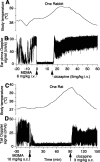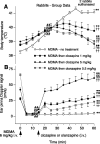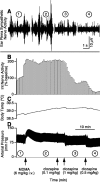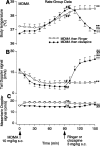Clozapine reverses hyperthermia and sympathetically mediated cutaneous vasoconstriction induced by 3,4-methylenedioxymethamphetamine (ecstasy) in rabbits and rats
- PMID: 12867524
- PMCID: PMC6740548
- DOI: 10.1523/JNEUROSCI.23-15-06385.2003
Clozapine reverses hyperthermia and sympathetically mediated cutaneous vasoconstriction induced by 3,4-methylenedioxymethamphetamine (ecstasy) in rabbits and rats
Abstract
Life-threatening hyperthermia occurs in some individuals taking 3,4-methylenedioxymethamphetamine (MDMA, ecstasy). In rabbits, sympathetically mediated vasoconstriction in heat-exchanging cutaneous beds (ear pinnae) contributes to MDMA-elicited hyperthermia. We investigated whether MDMA-elicited cutaneous vasoconstriction and hyperthermia are reversed by clozapine and olanzapine, atypical antipsychotic agents. Ear pinna blood flow and body temperature were measured in conscious rabbits; MDMA (6 mg/kg, i.v.) was administered; and clozapine (0.1-5 mg/kg, i.v.) or olanzapine (0.5 mg/kg, i.v.) was administered 15 min later. One hour after MDMA, temperature was 38.7 +/- 0.5 degrees C in 5 mg/kg clozapine-treated rabbits and 39.0 +/- 0.2 degrees C in olanzapine-treated rabbits, less than untreated animals (41.5 +/- 0.3 degrees C) and unchanged from pre-MDMA values. Ear pinna blood flow increased from the MDMA-induced near zero level within 5 min of clozapine or olanzapine administration. Clozapine-induced temperature and flow responses were dose-dependent. In urethane-anesthetized rabbits, MDMA (6 mg/kg, i.v.) increased ear pinna postganglionic sympathetic nerve discharge to 217 +/- 33% of the pre-MDMA baseline. Five minutes after clozapine (1 mg/kg, i.v.) discharge was reduced to 10 +/- 4% of the MDMA-elicited level. In conscious rats made hyperthermic by MDMA (10 mg/kg, s.c.), body temperature 1 hr after clozapine (3 mg/kg, s.c.) was 36.9 +/- 0.5 degrees C, <38.6 +/- 0.3 degrees C (Ringer's solution-treated) and not different from the pre-MDMA level. One hour after clozapine, rat tail blood flow was 24 +/- 3 cm/sec, greater than both flow in Ringer's solution-treated rats (8 +/- 1 cm/sec) and the pre-MDMA level (17 +/- 1 cm/sec). Clozapine and olanzapine, by interactions with 5-HT receptors or by other mechanisms, could reverse potentially fatal hyperthermia and cutaneous vasoconstriction occurring in some humans after ingestion of MDMA.
Figures




Similar articles
-
5-hydroxytryptamine(2A) receptors regulate sympathetic nerves constricting the cutaneous vascular bed in rabbits and rats.Neuroscience. 2003;117(4):939-48. doi: 10.1016/s0306-4522(02)00810-2. Neuroscience. 2003. PMID: 12654345
-
Spinal 5-HT2A receptors regulate cutaneous sympathetic vasomotor outflow in rabbits and rats; relevance for cutaneous vasoconstriction elicited by MDMA (3,4-methylenedioxymethamphetamine, "Ecstasy") and its reversal by clozapine.Brain Res. 2004 Jul 16;1014(1-2):34-44. doi: 10.1016/j.brainres.2004.03.058. Brain Res. 2004. PMID: 15212989
-
Clozapine and olanzapine, but not haloperidol, reverse cold-induced and lipopolysaccharide-induced cutaneous vasoconstriction.Psychopharmacology (Berl). 2004 Oct;175(4):487-93. doi: 10.1007/s00213-004-1850-6. Psychopharmacology (Berl). 2004. PMID: 15083260
-
[The change from clozapine to olanzapine--same effect?].Tidsskr Nor Laegeforen. 2000 Mar 20;120(8):945-6. Tidsskr Nor Laegeforen. 2000. PMID: 10795501 Review. Norwegian. No abstract available.
-
The role of monoamines in the changes in body temperature induced by 3,4-methylenedioxymethamphetamine (MDMA, ecstasy) and its derivatives.Br J Pharmacol. 2010 Jul;160(5):1029-44. doi: 10.1111/j.1476-5381.2010.00722.x. Br J Pharmacol. 2010. PMID: 20590597 Free PMC article. Review.
Cited by
-
Molecular and cellular mechanisms of ecstasy-induced neurotoxicity: an overview.Mol Neurobiol. 2009 Jun;39(3):210-71. doi: 10.1007/s12035-009-8064-1. Epub 2009 Apr 17. Mol Neurobiol. 2009. PMID: 19373443 Review.
-
Clozapine modifies the differentiation program of human adipocytes inducing browning.Transl Psychiatry. 2016 Nov 29;6(11):e963. doi: 10.1038/tp.2016.230. Transl Psychiatry. 2016. PMID: 27898069 Free PMC article.
-
Dantrolene sodium fails to reverse robust brain hyperthermia induced by MDMA and methamphetamine in rats.Psychopharmacology (Berl). 2023 Apr;240(4):785-795. doi: 10.1007/s00213-023-06321-x. Epub 2023 Jan 26. Psychopharmacology (Berl). 2023. PMID: 36700960 Free PMC article.
-
Orexinergic neurotransmission in temperature responses to methamphetamine and stress: mathematical modeling as a data assimilation approach.PLoS One. 2015 May 20;10(5):e0126719. doi: 10.1371/journal.pone.0126719. eCollection 2015. PLoS One. 2015. PMID: 25993564 Free PMC article.
-
The role of the sympathetic nervous system and uncoupling proteins in the thermogenesis induced by 3,4-methylenedioxymethamphetamine.J Mol Med (Berl). 2004 Dec;82(12):787-99. doi: 10.1007/s00109-004-0591-7. Epub 2004 Nov 10. J Mol Med (Berl). 2004. PMID: 15602689 Review.
References
-
- Aghajanian GK, Marek GJ ( 1999) Serotonin and hallucinogens. Neuropsychopharmacology 21: 16S–23S. - PubMed
-
- Arnt J, Skarsfeldt T ( 1998) Do novel antipsychotics have similar pharmacological characteristics? A review of the evidence. Neuropsychopharmacology 18: 63–101. - PubMed
-
- Baldessarini RJ, Frankenburg FR ( 1991) Clozapine. A novel antipsychotic agent. N Engl J Med 324: 746–754. - PubMed
-
- Barnes NM, Sharp T ( 1999) A review of central 5-HT receptors and their function. Neuropharmacology 38: 1083–1152. - PubMed
Publication types
MeSH terms
Substances
LinkOut - more resources
Full Text Sources
Medical
